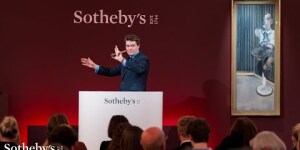New Waves: Mohamed Melehi and the Casablanca Art School Archives
Born in Morocco in 1936, Mohamed Melehi is regarded as the cornerstone of postcolonial Moroccan art and of modernism in the Global South. A painter, photographer, muralist and designer, Melehi became a leading figure in the radical Casablanca Art School and was at the helm of the artistic and cultural developments of post-colonial Morocco. In this work, the artist captures a post-modern aesthetic with the cultural richness of Moroccan-Berber crafts, driven by the lifeblood of social activism and a commitment to local artistic spirit. Melehi graduated from the École des Beaux-Arts, Tétouan, Morocco in 1955 and continued his fine art studies through the late 1950s, studying painting in Seville and Madrid, honing his sculpting skills at the Accademia di Belle Arti in Rome and learning about engraving in Paris.
In 1962, he accepted a scholarship to study at Columbia University in New York, a time when the city was a hub for post-modern artistic development – the Abstract Expressionist movement and the Color Field movement played a pivotal role to the burgeoning art scene that Melehi experienced during his time there.
It was while in New York that Melehi truly began to develop his own style. The works he produced there differed from the paintings he made in Italy: his lines and forms became clearer and smoother, a nod to Op Art and the clear impression that artists such as Frank Stella and Jasper Johns had on him. This also came hand in hand with the beginnings of a bolder, more brilliant colour palette. The hard-edged blocks of colour from Stella and the abstracted, almost ubiquitous motifs of Johns very clearly found their way into Melehi’s visual narrative – all incorporated at a time where these aesthetic paradigms prevailed. His passion for jazz developed in the City and found expression in the artist’s almost rhythmic, staccato-esque blocks of colour.

Following those formative years in New York, Melehi’s return to Morocco in 1964 marked the start of a more community-based approach to his creative output, when he began to explore his cultural heritage as a primary source of inspiration. The artists and activists of the Casablanca School of Fine Arts, where Melehi was professor until 1969, radicalized and inspired the national contemporary art scene by calling for a return to African and Berber sources. Together, they encouraged their students to study rugs, jewellery, leatherwork, tattoos, decorative painting in mosque and zawiyas of the Souss region to seek the potential of these popular Moroccan art forms in terms of geometric abstraction and “modernism”, resulting in a multi-cultural repertoire of forms and symbols with complex interconnections between Berber and African, Islamic and Mediterranean.

In the 1970s, when the present lot was painted, we began to see a shift from Melehi’s linear paintings to the iconic flame and wave shaped undulations that are unique to his opus. These new wave motifs, which embodied a symbolism that was both personal and political, developed along with his programme of divergent geometry. His multiple and overflowing variations on the “wave” suggest cosmic relations, playing out between the sun, the moon, the sea, the horizon; but also new possibilities for transnational solidarities and utopias. The interplay between earth and heaven or fire and wind, allude to Melehi’s bold spirit – in the assurance of his colour delineations it feels embodied in the panel. He also explored this pattern beyond painting, through prints, posters, and books, in his role as a cultural activist with organisations such as the Union of Arab Plastic Artists, which met throughout the 1970s in Damascus, Rabat, and Baghdad – where Melehi and his Casablanca colleagues participated in the first pan-Arab Biennale, in 1974.
In 1978, Melehi partnered with Mohamed Benaissa, the mayor of his home town Asilah, to co-found the Al Mohit association, a non-political organization with purely cultural objectives to restore and revitalise the city. This led to the establishment of the Cultural Moussem of Asilah, an annual arts festival that continues to be held every year, which is known for its program of ephemeral outdoor murals displayed in the streets of the medina. The project revitalized the formerly dilapidated appearance of Asilah, which is now celebrated for its vividly coloured murals, many of which have been created by Melehi himself.
"… on Arab soil, in Asilah, a fragment of the Third World, where men from North and South will find a permanent centre for cultural diffusion, rich in authenticity and steeped in heritage … where people will be able to define their distinctive features, their fundamental characteristics and their values… The ministry of culture restored a section of the city ramparts. We refurbished the large and luxurious ‘Raissouni Palace' and transformed it into a ‘palace of culture.' We installed art studios and equipped a hall, which was reserved for cultural gatherings. We created an open-air theatre in the old section of the city within the Portuguese walls. We also provided an area for film projections and organized a permanent exhibition of plastic arts." (Benaissa and Melehi joint essay in Asilah: Premier Moussem Culturel, Casablanca, 1979)
The present lot is one of a series of cellulose works he painted in Casablanca specifically for the third Cultural Moussem of Asilah in 1980. Melehi's fruitful work in the 1970s and 1980s reveals a demanding search for a modern form of representation and releases a transversal aesthetic specific to the articulation between figuration and abstraction, and between identity and modernity.
Melehi, who currently lives and works between Marrakesh and Tangiers, has exhibited extensively internationally and his work is held in international museum collections including, Tate, London; British Museum, London; Centre Georges Pompidou, Paris; Institut du Monde Arabe, Paris; The Museum of Modern Art (MoMA), New York; and, Mathaf: Arab Museum of Modern Art, Doha.
We are grateful to the artist for his assistance in cataloguing this lot.


